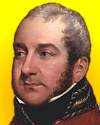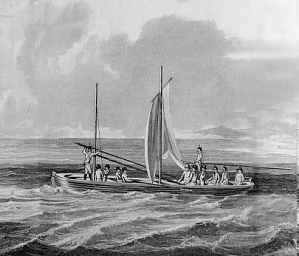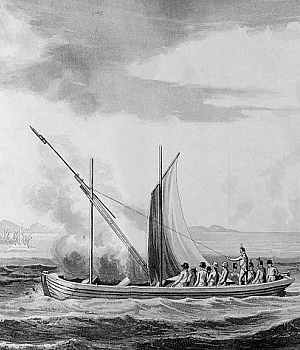 (source)
(source)
|
Sir William Congreve
(20 May 1772 - 16 May 1828)
English artillery officer and inventor who is remembered for his invention of military rockets, but had a variety of other innovations and held 18 patents.
|
Sir William Congreve
Obituary from Gentleman’s Magazine (1828)


[p.178] May...At Toulouse, aged 56, Sir William Congreve, second Baronet of Walton in Staffordshire, Knight of St. Anne of Russia. M. P. for Plymouth, senior Equerry to the King, Comptroller of the Royal Laboratory and Superintendant of the Military Repository at Woolwich, and F. R. S.
This celebrated member of the world of science was of a junior branch of the Congreves, of Congreve, in Staffordshire. William has been a favourite name of the family ever since the celebrated poet (who was described from a common ancestor in the time of Charles I.) acquired his literary fame. The deceased was born May 20, 1772, the eldest son of Lieut-Gen. Sir William Congreve, the first Baronet, by his first wife Rebecca Elmsion. The General died in 1814 in possession of the same offices at Woolwich as his son has ever since filled. The latter entered early into the same branch of military service as his father had pursued. He had in 1816 attained the rank of Lieut.-Colonel in the Artillery; and was then Equerry to the Prince Regent. Retaining the latter honourable appointment, he had retired in 1820 from his military rank.
It was in 1808 that he first invented that formidable engine of warfare, the Congreve rocket, which he succeeded in establishing as a permanent instrument of the military and naval tactics of the country, and which foreign nations have found it imperatively necessary to adopt. Having been tied and approved, it was used by Lord Cochrane in Basque Roads, in the expedition against Walcheren, in attacks on several places in Spain, at Waterloo, and with most serviceable effect in the attack on Algiers. For the effect of the Congreve rockets at the battle of Leipsic in 1813, the order of St. Anne of the 2d class was conferred on Sir William by the Emperor of Russia, and when the Emperor visited England in 1814 he was particularly interested by an exhibition of their powers at Woolwich (see a particular account in vol. LXXXIV. i. 615.) Sir William had a private factory at West Ham in Essex. The rockets have also been employed in a modified form, in the whale fishery.
But the Congreve rocket, though the most important, was only one of very many scientific inventions by which Sir William benefited himself and the world. On several of these he published treatises. In 1812 he issued an “Elementary Treatise on the Mounting of Naval Ordnance; shewing the true principles of construction for the carriages of every species of Ordnance,” 4to.
In 1811 Sir William Congreve was elected Fellow of the Royal Society. In 1812 he was returned to Parliament for Gatton, and in 1820 and 1826 for Plymouth. He succeeded his father in the Baronetcy April 30, 1814.
In 1815 appeared “A description of the construction, properties, and varieties of the Hydro-Pneumatic Lock,” for which he obtained a patent in that year, and which is now so generally adopted on canals. This invention formed a due propitiation to the genius of Peace after the assistance his other important discovery had given to the sanguinary [p.179] means of War; and elicited many a deserved compliment to those talents which had before enabled him to add to the military power of his country, and now to multiply the resources of its internal prosperity.
In the same year Sir William obtained a patent fur a new mode of manufacturing gunpowder. This invention consisted, first, in a machine for producing as perfect a mixture as possible of the ingredients; and secondly, in an improved mode of passing the mill-cake under the press, and a new granulating machine.
In 1819 a patent was granted to him for an improved mode of inlaying or combining different metals; and another for certain improvements in the manufacture of bank-note paper for the prevention of forgery [see below]. In 1823 Sir William published, by order of government, a very interesting report on the Gas-light Establishments of the Metropolis [see below].
After recounting these, his important benefits to society, it is melancholy to have to class him with those individuals of previous respectability, the influence of whose example decoyed so many weaker minds to ruin, during that mania for speculation which, two years ago, desolated with such cruelly the commercial community. On the ebbing of the tide, Sir William, like his brother senator the late Mr. Peter Moore, was washed by the current from his native shore, destined to a perpetual, although at the same lime a short-lived, exile. It was on the third of May in the present year (not many days before Sir William’s death) that judgment was pronounced in the Court of Chancery, on an appeal from that of the Vice-Chancellor, in the ease of the Arigna Mining Company. The Lord Chancellor then stated that “the bill charged a transaction which was clearly fraudulent. Sir William Congreve entered into a treaty with one Flattery, for the sale of certain mines for 10,000l. on behalf of a company of which be was to be the director. The two Clarkes afterwards associated themselves with him, and it appeared that they were desirous of securing a larger profit than they could receive as shareholders. They therefore settled that a conveyance should first be made to persons nominated by them for 10,000l. and that those nominees should afterwards convey to the company for 25,000l. in order that the difference might go into the pockets of Congreve, the Clarkes, and other persons.” Such is the history of the transaction as related by the Lord Chancellor on the third of May; but his Lordship concluded by repeating, what he had before expressed, that he wished it to be understood that he had refrained from giving any opinion as to the conduct of persons who had always been characters of great respectability until they had, by their answers to the bill, explained the charges. His Lordship affirmed, however, what the Vice-Chancellor had previously ordered in the business, and overruled the demurrer, giving the parties six weeks time to answer. Whether any thing further has been settled in the business we are not at present informed.
In announcing the death of Sir William Congreve, the Moniteur French newspaper mentions a report, “that, having foreseen for some time that war would break out in the East, he had submitted two projects to his Government, one for the defence of Constantinople, and the other for its destruction, according as England might be favourably or inimically disposed towards the Turks. Towards the latter part of his life,” continues the same writer, “having lost the use of his legs, he had invented a chair or sofa, which enabled him to move himself about his apartment without any assistance; this machine occasionally served him for a bed. He latterly also discovered means of propelling ships at sea, without the aid of oars, sails, or steam. The details of this plan were printed; it appeared, however, to be more ingenious than practicable. He has left a widow, several children, and an immense fortune.”—As much of this wears the air of improbability, the last assertion may be seriously doubted; and his family cannot be very large, as he was not married until the latter part of 1824. His union then took place at Wesel, in Prussia, with Isabella, widow of Henry Nisbett M’Evoy, esq. If Sir William has left a son, the child has of course succeeded to the baronetcy; if not, it is inherited by his brother, Lieul.-Col.Thomas-Ralph Congreve.
The remains of Sir William were interred on the 16th of May in the Protestant cemetery at Toulouse.
New Bank Note Paper
Sir William Congreve has invented a new Bank note paper and stamp, to prevent forgery of country notes. The paper, which is called triple paper, is coloured throughout in the interior, but not on the surface, which forms a brilliant and indelible water-mark. Every note of the triple paper is dipped three times, and couched1 twice, as it is technically termed, instead of only one dipping and one couching, as in the ordinary paper. The price is one fourth more than common paper.
[1 Couching: Pronounced “cooching” (from the French coucher, “to lay”), is the process of transferring the wet sheet from the mold to another surface (the felt) to dry. (source)]
Gas Lights
Sir William Congreve has, by the order of Government, published a very interesting report relative to the Gas Light Establishments of the Metropolis. The objects of his inquiry have principally been directed to the state of the various main and branch pipes, which have been some time in use, the means employed by the several companies to produce and purify Gas, the methods adopted for the suspension of gasometers, and the comparative strength of gunpowder and coal gas. Sir William has ascertained that a Gasometer of 80,000 cubic feet capacity, when rendered explosive by a certain proportion of atmospheric air, would be equal in effects to 62 barrels of gunpowder! ! He disapproves of the practice of suspending Gasometers by a chain and counterpoise; and points out to Government the propriety of enforcing Mr. Clegg’s (Engineer to the Imperial Company) admirable, safe, and economical plan.
Funeral Car
Designed by Sir William Congreve
[p.430] Thus died, Nov. 17, 1818, in the 75th year of her age, and the 57th after landing in England, Her Most Excellent Majesty Charlotte Queen-Consort of George III.
[p.435] [The Funeral] At eight o’clock in the evening the procession reached the south door of St. George’s chapel, where the servants and grooms, the trumpets and drums, and the Knight Marshal’s men filed without the door. The royal body was then removed by ten yeomen of the guard from the hearse, and placed upon a car constructed by Sir William Congreve. On all former occasions the coffin was carried into the church on the shoulders of yeomen of the guard, but the weight was often found insupportable, and after the interment of the Princess Charlotte, it was said that one of the bearers had actually died of the injury he sustained in the performance of this duty. To obviate, we presume, not only a recurrence of this injury, but even the unpleasant interruption which the change of bearers to relieve each other necessarily occasions in the church during the performance of the solemn ceremony, this car was contrived. The surface of it was flat, with a groove to receive the shape of the coffin: it was about five feet in height, and was supported by three separate axle-trees, which moved two small wheels each; the axles were constructed to swing with facility, and make a short turn in a small circle, so as to perform [p.436] its evolutions with ease on the platform: this car, which was entirely covered with black velvet, was placed at the end of the covered way facing the great gate, where it received the coffin. It was then drawn on, after the procession formed in the interior, in the order it originally held along the platform, and up to the choir, by yeomen of the guard, who worked at its handles, but who were concealed from public view by a large velvet pall which was thrown over the coffin, and hung down at the sides so as to cover the men who drew the car at each side.
This ingenious and humane alteration gave the spectacle at the moment the procession passed up the body of the chapel, a feature of novelty, which it was impossible not to approve. — Ten escutcheons adorned the pall, and the solemn effect produced on the spectators by the view of an object so interesting, slowly advancing, apparently from a motion of its own, to the yawning mouth of the sepulchre, preceded by the ministers of religion, and followed by the most exalted individual in this kingdom, and the most distinguished of the nobility and great officers of state, was as striking and affecting as it was mournfully magnificent.
- Science Quotes by Sir William Congreve.
- 20 May - short biography, births, deaths and events on date of Congreve's birth.
- Commodore Squib: The Life, Times and Secretive Wars of England's First Rocket Man, Sir William Congreve, by James Earle. - book suggestion.
- Booklist for Sir William Congreve.




